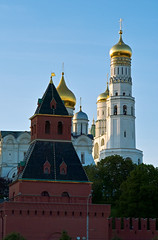 Image by liilliil via Flickr
Image by liilliil via FlickrI'm loving the BBC series Russia: A Journey with Jonathan Dimbleby. A journey across ten thousands miles of Russia that started in Murmansk and then follows Dimbleby to the other side of the country. It's being lauded as a landmark production, and the quality of the programming is without doubt. It's also great to see Russia and Russians up close in such detail. This is a country where the language needs a whole book (or maybe two) to list all the ways of saying 'to go', and where a real journey isn't just a journey but a, untranslatable, puteshestvie. You need to travel Russia to really see it and to really appreciate it.
My own travel in Russia has been limited - I've wanted to take the Trans-Siberian or Trans-Mongolian across the country but to date my train journeys have been much shorter. I lived in St Petersburg for a few months once and we often travelled to Moscow for weekends by train. Usually sharing benches or bunks with Russian military who wanted to do little more than drink the night away. Great for my Russian (and for my vodka drinking skills!) but the last time I took the trip I did it in a different style.
At least ten trains travel between Moscow and St Petersburg every night and they are almost always all full. The premium choice is train number 001/001 - the Red Arrow (Krasnaya strela, Красная стрела). We boarded this sleek train shortly before midnight at the the Leningradskii Station in Moscow. We were welcomed by a friendly provodnitsa with blankets, a breakfast boxand to take our drinks requests. A band plays us off as we leave the station, and we down vodka - this time in official Russian Railways glasses, not direct from the bottle of a drunken soldier next to me.
The train has everything you need - restaurant, bar, samovar for hot water. And if you're in one of the new deluxe cabins you even get a DVD and entertainment system. Or you can just settle back and enjoy the eight hour journey across European Russia to St Petersburg. Although don't miss all the excitement. The Russians enjoy journeys and the train is alive with drunkards playing cards and drinking vodka, families moving house, grandmas going back home from a visit to the capital, businessmen off for a day's work and then young people - here to have fun away from home. Just wander up and down the train to soak up the vibrancy, or settle down in the bar and let the vibrancy come to you.
You arrive next morning in St Petersburg - a truly beautiful city in a way Moscow never was and never could be. Be warned though: the Moskovskii station at St Petersburg has a chilly wind blowing through it's tall communist-design at the best of times, and in winter months leaving the warm and homely train will probably be a struggle.
You don't need to buy train tickets in advance. In fact the prices quoted on sites that sell tickets to westerners seem extortionate. If you turn up the day before and are either not too fixed on a certain train, or are buying the more expensive tickets, then you will be able to buy them direct from the station at Moscow or St Petersburg. You'll need some Russian (or to have written down what you want on paper) to get what you want and the staff aren't renowned for their politeness. But a bit of persistence and you'll get what you came for. You may also have visa problems - technically you need a stamp covering your entire stay and you won't get one on the train. Don't worry though - most visa agencies abroad, and many hotels in Russia, will sort this out for you.
These hassles aside, the real Russian travel experience begins at the station so join the locals on their puteshestvie.




